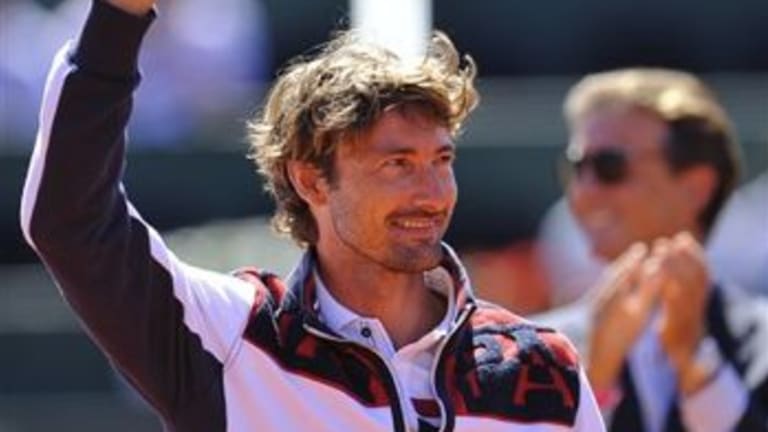A few seconds after David Ferrer won the title in Valencia on Sunday, two odd things happened.
First, as Ferrer began to jog off the court to find someone in the stands, the arena’s DJ cued up...“Call Me Maybe.” Was he worried that Ferru was never coming back to the tournament that he owns?
Second, Ferrer continued out of the court and along the front row until he found...Juan Carlos Ferrero. The winner didn’t look for his coach, or his trainer, or his girlfriend. Instead, he went to hug another player, one who had lost earlier in the same event.
Of course, Ferrero wasn’t just any other player. He’s a co-owner, with Ferrer, of the Valencia event. He had just finished playing the final tournament of his impressive 14-year career a day or so earlier. And he has always been among the most popular ATP players, especially with his fellow Spaniards. Many of them, including Rafael Nadal and Carlos Moya, had made a special trip to Valencia earlier in the week to pay tribute to the man who had led their first Davis Cup title crusade in 2000, and who had inspired them all with his French Open win three years later.
Ferrero is 32 now, and his Grand Slam wins were far behind him. So his retirement makes sense. What makes it even more appropriate is that it comes just two months after Andy Roddick called it quits. The two men had similar career arcs: Each won his only major in 2003 (Ferrero at Roland Garros, Roddick at the U.S. Open). Each briefly reached No. 1 the same year. Each was subsequently overshadowed by the next wave of champions, led by Roger Federer and Rafael Nadal. And each came to the game with a shot that was state of the art at the time—Roddick’s serve, Ferrero’s forehand—but wouldn’t look quite as special as the years went by and the men’s power surge went on. Ferrero and Roddick were going to be legends, but they ended up as transitional figures, bridges between generations. It wasn’t easy for either of them to accept that fact, but they did, and they went on to have honorable careers in their own rights.
Three years ago, as Ferrero was mounting his last significant climb up the rankings in the summer of 2009, I wrote a piece about him called "The Man Who Won't Be King." Juan Carlos was named after the current Spanish monarch, but he had to sit on the sidelines as the younger Nadal took over as the king of clay, and the king of Spanish tennis. The switch began in 2004, when Ferrero watched unhappily as an 18-year-old Nadal was chosen over him for a singles spot in the Davis Cup final against the United States. At that point, Ferrero owned a French Open title, while Nadal had never even played the tournament. But the future was already at hand, as Nadal beat—guess who?—Roddick on the tie’s opening day. Suddenly, Nadal’s very powerful and very consistent topspin forehand was the new state of the art. Ferrero wouldn’t win another title for five years.
Ferrero, who was universally described as “a proud man,” played on, through multiple injuries, as a second-tier star in the shadows of younger, springier athletes and fancier ball-strikers like Nadal, Roger Federer, and Novak Djokovic. When he finally did win another title, in Casablanca in 2009, his reward was to be asked, at every press conference for the rest of that season, if he was thinking back to his glory year of 2003. By then, JC was focused on the here and now, and had little time for the past. That summer he was asked, “Is it difficult, after being on top, to come back and have to play qualifying?”
“Of course,” Ferrero said, “it’s tough to play qualies when you’ve been blah blah blah. So it is what it is.”
Like Roddick, Ferrero may go down historically as a player who took his opportunity while the Sampras-Agassi generation was fading and before the Federer-Nadal era had launched. But Ferrero, with his clean strokes and calm demeanor, was still a pleasure to watch—his forehand, while it wouldn’t always be state of the art, would always be a model of ball-striking grace and efficiency. My main memory of him as a player will always be a juxtaposition of two similar moments, from five years apart, at the U.S. Open:
The first came on the Grandstand in 2004 or 2005. Ferrero had been blown out in the first set. After the last point, he walked over to the sideline, let his racquet drop to the court, and stared at his entourage. It looked like he was about to cry. In ’09, I watched him get blown out in another first set, this time deep on the side courts where he made his living by that point. This time, like that earlier time, he walked to the sideline, let his racquet drop to the court, and stared at his entourage. Instead of appearing to be on the verge of tears, though, he shook his head and gave his team a wry smile. Juan Carlos, king for a day, was OK with where he had ended up.
